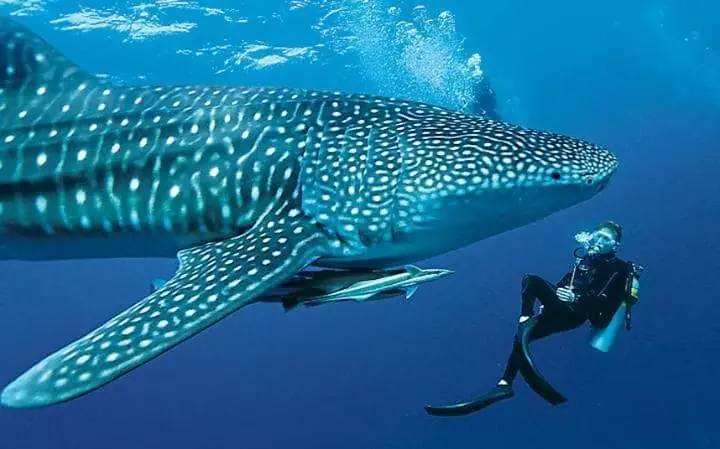The whale shark is the largest shark and the largest fish. It is named whale shark because of its huge whale-like body. The largest whale shark scientifically recorded is 12.65 meters long, which is equivalent to the length of 3.5 Mini Cooper cars. (Guinness World Record)

At this time, some friends will ask, isn't the blue whale the largest? This is because the blue whale is a viviparous mammal, not a fish, so the whale shark is currently the largest fish in the world.
Despite their size, whale sharks are gentle creatures. They are often used by scientists to educate the public that not all sharks are "man-eaters". They also play with divers. There is an unconfirmed report that whale sharks will remain still and turn their bodies upside down to allow divers to clean parasites from their abdomens. Divers can swim with these huge fish without any danger, except for being accidentally hit by the whale shark's huge tail fin.
Whale sharks are active filter feeders, feeding on plankton, giant algae, krill, and small free-swimming animals (such as small squid and vertebrates). Their teeth are not used for foraging, in fact, they are not large in size. Instead, whale sharks take a gulp of water, close their mouths, and then expel water through their gills. During the brief period between the mouth closing and the operculum opening, plankton is trapped by the dermal denticles that line the gills and throat. This filter-like organ is a unique variation of the gill rakers, which prevents anything larger than 2 to 3 mm from passing through, and fluid is expelled. Anything that is blocked by the filtering organ between the gill rakers is swallowed by the whale shark. Whale sharks have been observed to "cough", which is speculated to be a way of clearing food that has accumulated in their gill rakers. This is in stark contrast to basking sharks, which are gentle filter feeders and do not inhale seawater, but force it through their gills by swimming. A whale shark was filmed feeding on a small fish in the BBC nature documentary Planet Earth.
The skin below the scales on the back of a whale shark can be up to 10 cm thick and has a rubbery texture that protects it from predators such as killer whales. They can make their skin tougher by tightening their back muscles. Some marine mammals are said to have even thicker skin.
Whale sharks are often surrounded by some small fish that "hitchhike" on them, such as remora and golden trevally.
Whale sharks have almost no natural enemies, and human fishing is one of the reasons for their decline. Whale sharks are one of the targets of aquaculture in several seasonal gathering areas. Southeast Asia, especially Taiwan, China, is the main fishing area for whale sharks. The whale sharks caught are mainly eaten for their meat, and sometimes their fins are cut off to make shark fins. Although they are not the target of fishing in other places, they will also be caught by mistake.
In 1998, the Philippines banned all commercial hunting, trafficking, import and export activities of whale sharks, while India banned it in May 2001. Since 2003, Taiwan has limited the number of whale sharks caught to 80 per year. Since January 1, 2008, such commercial activities have been completely banned.
Listed in the "IUCN Red List of Endangered Species" (IUCN) 2016 ver3.1-Endangered (EN).
Listed in Appendix I, Appendix II and Appendix III of the Convention on International Trade in Endangered Species of Wild Fauna and Flora (CITES) 2019 Edition Appendix II.
Listed in China's "National Key Protected Wildlife List" (February 5, 2021) Level 2.
Protect wildlife and eliminate game.
Maintaining ecological balance is everyone's responsibility!